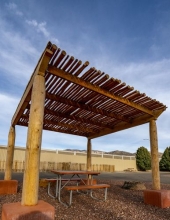I don't have any need, I'm stuck for the time being in an apartment with a drawing pad. I'm hoping to have land to actually, you know, do something later this year. And test it I will! And much else, at least if it seems worth doing.
We get 7" a year of rain where I am, I'm thinking of different "natural" materials to make a mud brick vaulted roof durable here, no Portland. In Iran they cover such roofs with square ceramic tiles that look a lot like the local Mexican tile. They also do a kind of trencadis. There's that possibility, like a patio floor on the roof. Lime plasters work for some. Seems like the raw earth roofs last maybe a year or two in Iran, with similar rainfall although I don't get any ice here in the low desert. So the thought came to me, hey what would it do if you could fire it as a whole, make one big tile, or like a big inverted teacup of it?
Have you heard of architect Leon Krier? He contrasts modern buildings with traditional by initial time investment vs building lifetime maintenance. So modern buildings go up quickly but long term cost of maintenance is high. Traditional buildings are slow to put up, but cost a lot less over their lifetimes.
Now take this idea over to typical Arizona suburban home construction vs some natural building type for the climate. The additional time and labor to build an adobe vault roof vs the current prefab frame strut sandwich things has to be offset but much longer lifetime, to be a real alternative.
In sum, I'm wondering if that's possible, and if so what does it. For example, the method should provide at least 25 years before needing any real attention, that seems like a reasonable span. And at that point it shouldn't need a total replacement.




